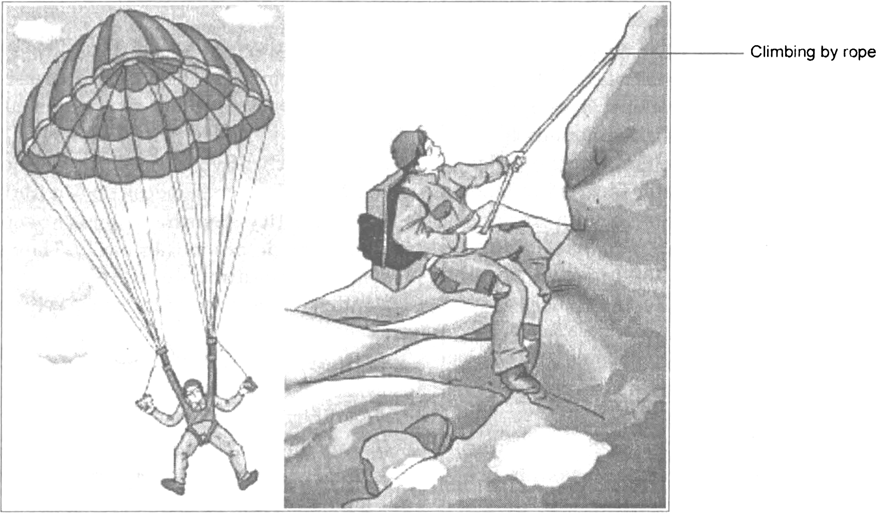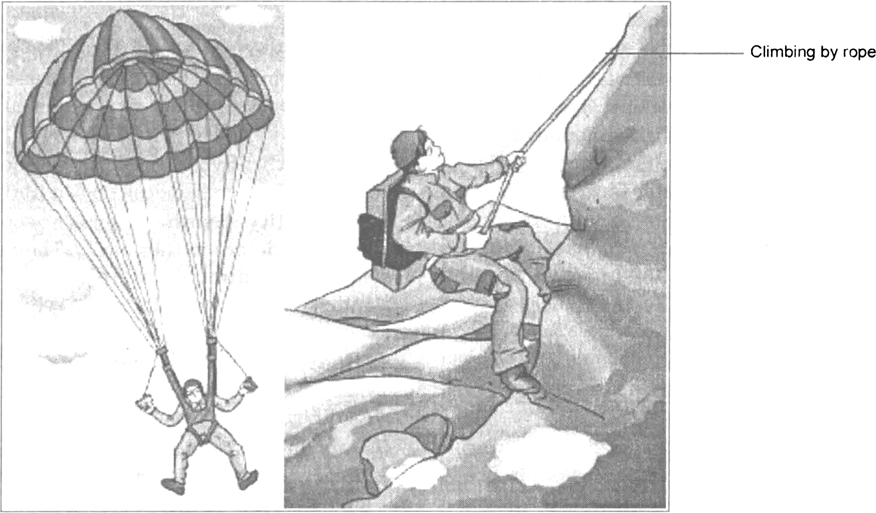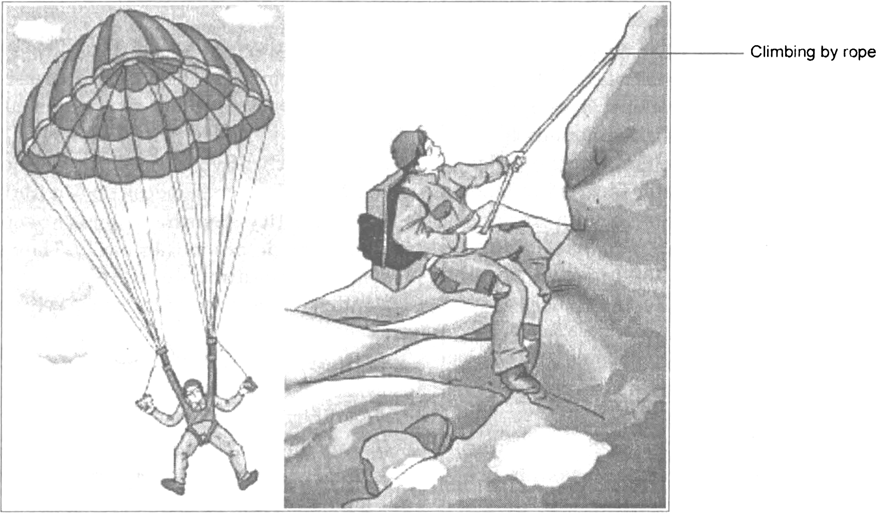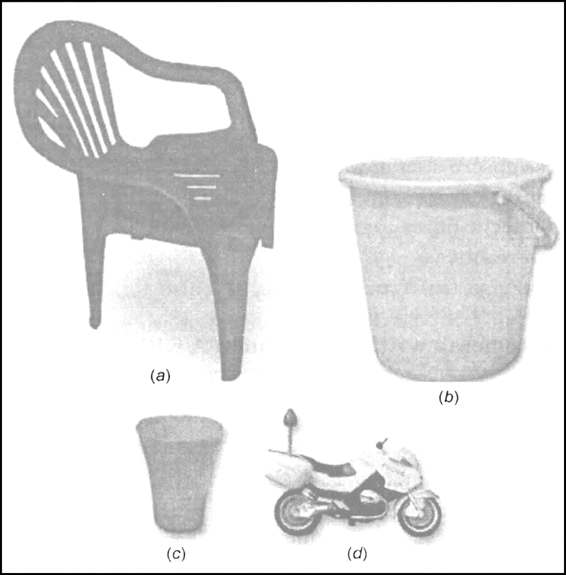Science Chapter 3 Synthetic Fibres And Plastics
Sponsor Area
NCERT Solution For Class 8 Social+science
Explain why some fibres are called synthetic.
Some fibres are called synthetic because they do not occur naturally and are made by man using petrochemicals.
Rayon is different from synthetic fibre because
it has a silk like appearance
it is obtained from wood pulp
its fibres can also be woven like those of natural fibres
B.
it is obtained from wood pulp
Give examples which indicate that nylon fibres are very strong.
Nylon fibres are very strong, thus they are used to prepare ropes for mountaineering. They are also used to prepare parachutes.
Explain why plastic containers are favoured for storing food.
Advantages of storing foods in plastic containers are :
(a) The plastics do not react with the food stored in them.
(b)The plastics are light weight and are strong.
(c) They are easy to handle and safe.
(d) They are lower in price.
Explain the difference between the thermoplastic and thermosetting plastics.
|
Thermoplastics |
Thermosetting plastics |
|
1.These are the plastics which get deformed easily on heating and can be bent easily. |
1.These are the plastics which once module cannot be softened by heating. |
|
2. These are used for manufacturing toys, combs car grills and various types of containers. |
2. Bakelite are used for making electrical switches, handles of various utensils etc. ii) Melamine are used for making floor tiles, kitchen wares and fabrics which resist fire. |
|
Example: Polythene, and PVC(Poly vinyl chloride) |
Example: Bakelite and melamine |
Explain why the following are made of thermosetting plastics.
(a) Saucepan handles
(b) Electric plugs/switches/plug boards
Plastics which when moulded once, cannot be softened by heating. These are called thermosetting plastics.
a) Saucepan handles are made of thermosetting plastics because it resist fire and tolerate heat better than other plastics. Example of this kind of thermosetting is Melamine.
b) Thermosetting plastics such as bakelite are poor conductor of heat and electricity. Therefore, they are used for making electric, plug switches, plug board, etc.
Categorise the materials of the following products into ‘can be recycled’
and ‘cannot be recycled’:
Telephone instruments, plastic toys, cooker handles, carry bags, ball point
pens, plastic bowls, plastic covering on electrical wires, plastic chairs,
electrical switches.
Can be Recycled : Toys, carry bags, plastic bowls, ball point pens, plastic chairs, plastic covering on electrical wires.
Cannot be Recycled : Cooker handles, electrical switches, telephone instruments.
Rana wants to buy shirts for summer. Should he buy cotton shirts or
shirts made from synthetic material? Advise Rana, giving your reason.
1) Cotton clothes are preferred to synthetic clothes in summers because cotton allows better air circulation, which helps in absorbing and removing body moisture caused by sweat. It therefore minimizes fungal breeding by keeping your body dry and cool.
2) Cotton is light in weight and in colour unless it is dyed. being light coloured will help the light to pass through instead of being absorbed and hence we will not feel the heat as much.
Give examples to show that plastics are noncorrosive in nature.
Following examples show that plastics are non-corrosive in nature :
(i) They are used to store chemicals. For example cleansing chemical are very reacticve and store in plastic bottle.
(ii) They are used to store all types of food, as it does not react to materials stored in it.
(iii) It does not even react with air and water.
Should the handle and bristles of a tooth brush be made of the same material? Explain your answer.
No, the handle and bristles of a tooth brush should not be made of the same material because the bristles should be soft and the handle should be hard. So the bristles should be made up of soft material so that it does not harm the gums. The handles should be made up of hard material so that it can give firm grip.
‘Avoid plastics as far as possible’. Comment on this advice.
Plastics are harmful for our environment. Plastics are non- biodegradable. It add pollution to the environment. They cannot be burnt because, when they burnt they release poisonous gases. Some of the plastics cannot be recycled, so they cannot be used again and thus cannot be finally disposed off. They thus, should be avoided as far as possible.
Match the following of column I correctly with the phrases given in column II:
| A. Polyester | (i) Prepared by using wood pulp |
| B. Teflon | (ii) Used for making parachutes and stockings |
| C. Rayon | (iii) Used to make non-stick cookwares |
| D. Nylon | (iv) Fabrics do not wrinkle easily |
A. Polyester | (i) Fabrics do not wrinkle easily |
B. Teflon | (ii) Used to make non-stick cookwares |
C. Rayon | (iii) Prepared by using wood pulp |
D. Nylon | (iv) Used for making parachutes and stockings |
‘Manufacturing synthetic fibres is actually helping conservation of forests’.
Comment.
Manufacturing synthetic fibres is actually helping conservation of forests because raw material for natural fibers are mainly derived from plants and this means cutting a lots of trees. This leads to deforestation. But raw material of synthetic material are mainly petrochemicals.Therefore it does not require cutting plants to get the natural fibres.
Describe an activity to show that thermoplastic is a poor conductor of electricity.
We will design a circuit to see that thermosetting are poor conductors of electricity. We need a bulbs, some wires, and a batterys, a piece of metal, and plastic pipe. Set up the circuit first with the metal and then with the plastic pipes as (shown in figure). After you switch on the current, you will observe that the bulb glows in the former case. In the latter case, the bulb does not glow. Hence, a plastic pipe (which is a thermoplastic) is shown to be a poor conductor of electricity.
Sponsor Area
What are natural fibres?
The fibres obtained from plants or animals are called natural fibres.
What are polymers?
When a large number of small units combine to form a single large unit, then the large unit is called polymer. For example polythene is polymer made of small units ethene.
Name the fibre having properties similar to that of silk.
Rayon have similar properties of silk.
Which synthetic fibre is used for making fishing nets and parachute ropes?
Nylon is used to make fishing nets and parachute ropes.
Write the names of two articles made by nylon.
Parachutes, ropes for rock climbing and fishing net.
Write the burning characteristics of nylon.
Nylon fibre shrinks on burning forming beads and giving a smell of burning hair.
Give one example of natural amide polymer.
Natural silk and wool are natural amide polymer.
Define 'polyester'.
The polymer made up of the repeating units of ester is called polyster. Terylene is a popular polyester.
Name a synthetic fibre which works like wool.
Acrylic is synthetic fibre which works like wool.
What are plastics?
Plastic synthetic material made of many oraginc polymer such as polyethene, nylon etc., that can be moudlded into shape while soft, and then set into a rigid or slightly elastic form.
How many types of arrangement of units are in plastics? Name them.
There are two types of arrangement of units in plastics.
(i) Linear linking
(ii) Cross linking.
Sponsor Area
Why plastics are not eco-friendly?
Plastics take several years to decompose, so it is not eco-friendly.
Why is plastic covering used in electric wires?
Plastic like thermosetting is a poor conductor of electricity and heat. Hence, it used to cover electric wires.
Why are handles of frying pans, cookers are made of plastic material?
It is so because these are poor conductors of heat. They hardly allow to flow heat form them.
Which of the following is good for making handle of a pressure cooker– a thermoplastic or a thermosetting plastic?
Thermosetting plastic is used for making handle of a pressure cooker.
Mention two main problems associated with careless disposal of plastic bags.
The two main problems are:
(i) Soil pollution.
(ii) Blockage of drains and sewer lines.
What makes plastic a wonderful material?
Lightness, strength, durability, non-reactiveness and easily availble in market at lower cost.
Name the monomers for decron (or Terylene).
Ethylene glycol and Terephthalic acid are monomer of decron.
What is a better material for making PVC pipes–a thermoplastic or a thermosetting plastic?
Thermoplastic is better material for making of PVC pipes.
Explain why, synthetic fibres have become so popular.
Synthetic fibres have so popular because of their much superior properties as compared to natural fibres like cotton, silk and wool. For example :
(i) Synthetic fibres absorb very little water. So, the clothes made of synthetic fibres dry quickly after washing.
(ii) Synthetic fibres are very strong. So the clothes made of synthetic fibres last for a long time. It is also used for making parachutes and ropes for rock climbing.
Write one advantage and one disadvantage of using clothes made from synthetic fibres.
Advantage : They last longer as compared the fabrics made from natural fibres.
Disadvantage : Synthetic fibres are nonbiodegradable. Therefore, they cause soil pollution and sometimes they can also cause skin problems.
Mention two properties and two uses of polyvinyl chloride.
Properties of polyvinyl chloride :
(i) It is tougher than polythene.
(ii) It gets deformed easily on heating and can be bent.
Uses of polyvinyl chloride :
(i) It is used for making shoe-soles and shoes.
(ii) It is used for making rain coats and floor and ceiling fans.
Give any two differences between the natural and synthetic fibres.
|
Natural fibres |
Synthetic Fibres |
|
1.Natural fibres absorb a lot of water. So, the clothes made of natural fibres do not dry quickly after washing. |
1. Synthetic fibres absorb very little water. So, the clothes made of synthetic fibres dry out quickly after washing. |
|
2. Natural fibres have low strength, so the clothes made of natural fibres do not last for a long time. 3. Example; slik. |
2. Synthetic fibres are very strong. So, the clothes made of synthetic fibres last for a long time. 3. Example; nylon. |
What are the raw materials used in the preparation of bakelite? Write two its uses.
Raw materials used in the preparation of bakelite are :-
phenol and formaldehyde.
Uses of Bakelite :
(i) It is used for making electrical switches and plugs.
(ii) It is used for making gear wheels and table top laminates.
What advice can be given to a person wearing synthetic clothes while working in a laboratory or near the fire in the kitchen?
Cloths made of synthetic fibres melt on heating and catches fire, it can very disatrous. The fabrics melts and sticks to the body of the person wearing it. Therefore, it is advised to not wear synthetic clothes while working in a laboratory or working near the fire in the kitchen.
Why are plastics used widely in the industries and household articles?
Plastic is very light, strong, durable and can be moulded into different shapes and sizes. It is used for various purposes. Plastics are generally cheaper than metals. This is because they are widely used in industries and household articles.
What is 4R principle?
4R stands for
(i) Reduce : The use of nonbiodegradable materials.
(ii) Reuse : We should use the materials again and again.
(iii) Recycle : We should use the materials which can be recycled.
(iv) Recover : Recover the lacking substances.
Which plastic is used for making insulation (covering) of electric wires?
PVC (Poly-Vinyl Chloride)
How can polythene carry bags be harmful for animals?
Polythene carry bags are thrown here and there after using them. Stray cattle consume them. Since it is not digested by animal and it can choke the respiratory system and damage their stomach. It can even cause their death.
What are thermoplastics? Explain with examples.
Those plastics which can melt on heating and which can be reshaped on moulding again and again are called thermoplastics. P.V.C., Polythene are examples of thermoplastics. Toys, containers, car grills, combs etc. are made with thermoplastics.
What are thermosetting plastics?
Thermosetting plastics are those plastics, which can be only moulded for once. They cannot be reshaped or reused because they do not get softened on heating. Bakelite, melamine etc. are examples of thermosetting plastics.
Why the handles of the utensils are made of bakelite?
Bakelite is a thermosetting plastic. It is a bad conductor of heat. It does not allow heat to pass through it easily. So, it is used to make the handles of the utensils so that it does not get heated and it becomes easy to handle the cookware while cooking.
Why the switches and plugs are made of plastics?
Plastics are poor conductor of electricity and resistant to heat, so they do not allow the electric current to pass through them making them safe to handle. So they are used to make electric switches and plugs.
Out of the following materials :
Cotton, Nylon, Terylene, Wood, PET, Acrylic
Which materials are polyesters?
Terylene, PET are polyesters.
What are biodegradable and non-biodegradable materials?
Biodegradable substances are those substances which can be decomposed by bacteria and other natural processes. For example leaf, wood, silk etc.
Those substances which cannot be decomposed are called non-biodegradable substances. Plastics are non-biodegradable. For example polythene, nylon, plastics, etc.
Why plastics are considered as environmental threats?
Plastics are considered as threats to the environment because they are not easily decomposed. Being non-biodegradable its disposal is the major problem, which can pollute the environment.
What are biodegradable and non-biodegradable materials? Explain with examples.
Biodegradable materials : A material which gets decomposed through natural process, such as action by microorganisms is called biodegradable. For example, paper, leaves, vegetables, fruits etc.
Non-biodegradable materials : A material which is not easily decomposed by natural processes, such as action of microorganisms are called non-biodegradable materials. For example : Glass, copper, plastics, synthetic fibres etc.
Sponsor Area
Write two uses each of the following :
Polyvinyl Chloride
Bakelite
Uses of Polyvinyl Chloride :
(i) It is used for the manufacture of raincoats, hand bags, plastic dolls, bathroom curtains etc.
(ii) It is used for manufacturing flooring and floor/ceiling tiles.
(iii) It is used to manfacture pipes.
Uses of Bakelite :
(i) It is used for making electrical switches and plugs.
(ii) It is used for making gear wheels and table top laminates.
Name different artificial fibres and write their uses.
Following are the main artificial fibres with their uses:
(i) Rayon : Rayon called the artificial silk as it has great lustre and is light in weight. It is obtained by the chemical treatment of wood pulp. It can be woven like silk and dyed in different colours. It is used as dress material. Mixed with cotton, it is used to make curtains, bedsheets etc. It is mixed with wool to make beautiful carpets.
(ii) Nylon : It is the strongest fibre. It is made by coal, water and air. It is elastic in nature and light in weight. It is lustrous and thus ideal for making dresses. It is also used to make stockings, seat belts, ropes, tents, toothbrushes, sleeping bags, curtains and parachutes etc.
(iii) Polyester : It is made up of multiple units of ‘esters’. The clothings made of this fibre do not get wrinkled easily. It is always crisp and easily washable. PET is also derived from polyester which in turn is used to make containers, utensils, films, wires etc.
(iv) Acrylic : Acrylic is just like wool and is used to make sweaters and suit lengths.
How is polyester fibre prepared? Why do polyester clothes dry quickly after washing as compared to cotton clothes? Give two uses of polyester.
A polyester fibre is prepared by reacting a dicarboxylic acid with a dihydric alcohol. The reaction between acid groups and alcohol jumps of these two compounds leads to the formation of a long-chain polymer called polyester. A typical polyester fibre is terylene.
Polyester fibres absorb very little water due to which polyester clothes dry quickly after washing. On the other hand, cotton fibres absorb a lot of water due to which cotton clothes do not dry quickly after washing.
Uses :
(i) Polyester fibres are used in the manufacture of textiles like sarees, dress materials and curtains.
(ii) Polyester fibres are used for making sails of sail boats and water hoses for fire fighting operations.
Write the characteristic features of plastics.
Plastic is a wonder material. Following characteristic features make it a common and popular choice :
(i) Plastics are light in weight so they are easy to handle and manage.
(ii) Plastics are strong and durable so they are used to make buckets, mugs, ropes etc.
(iii) Plastics are non-reactive as they do not get corroded when they come in contact with other materials or substances. This property make them perfect for storing food items and chemicals.
(iv) Plastics are poor conductors of electricity. They do not allow the electric current to pass through them easily. They are, therefore, used to make coverings of electric wires and other electric appliances.
v) plastics are cheaper. Therefore everyone can afford it.
Describe the characteristic features of the synthetic fibres.
Synthetic fibres are made from chemical substances. Their qualities are quite different from those of natural fibres. Following are the characteristic features of the synthetic fibres :
1. Raw material : All synthetic fibres are made from chemicals. They are prepared by a number of processes using raw materials of petroleum family called petrochemicals.
2. Strength : Synthetic fibres are quite strong. Nylon is the strongest known fibre.
3. Durability : Synthetic fibres are quite durable. They do not wither easily. They are so strong and durable that ropes and parachutes etc. are made by using synthetic fibres.
4. Soak less water : Synthetic fibres absorb small quantities of water and loose it quick, so they dry up very soon.
5. Availability and cost : Synthetic fibres are less expensive and readily available. That makes it a popular dress material.
Give an activity to show that twisting of fibres into yarn increases the strength of fibres.
Procedure :
1. Take a 15-20 cm long loose strand of cotton fibre. Break it into two parts of nearly equal size. Twist one part of it to make a thread. Let the other piece be as such.
2. Hold the untwisted part and apply a pull on its both the ends till it breaks.
3. Repeat the same with the twisted part till it breaks.
4. Compare the pull required to break the twisted and the untwisted thread.
Observation :
Greater force (or pull) is required to break the twisted thread than the untwisted thread.
Inference :
Twisting of fibres into yarn (or thread) increases the strength of the fibres.
Observe the following figure and answer the following question:
Identify the articles used by the persons in the figure.
The articles are parachute and ropes for rock climbing.
Observe the following figure and answer the following questions :
Name the substance used in making these articles.
The substance used in making these articles is Nylon.
Observe the following figure and answer the following questions :
Why does this substance is used in making these articles?
Nylon is actually stronger and lighter than any other substance. Therefore, it is used to make these kind of article.
Draw a diagram to show the :
(a) Linear arrangement of units in plastic.
(b) Cross linked arrangement of units plastic.
a) Linear arrangment:![]()
b) Cross linked arrangment:
Observe the following articles and name the substances used in making these articles.
The articles are as follows :
(a) Chair (Thremosetting)
(b) Bucket(Thremoplastics)
(c) Glass (Thremoplastics)
(d) Toy Scooter (Thremoplastics)
________ is used to make the handles of cookware because it is ________to heat.
Melamine
,resistant
Match the following option:
| A. Small units making a fibre | (i) silk |
| B. Natural polymer | (ii) thermosetting |
| C. Plastics which cannot be reused | (iii) polythene |
| D. cotton | (iv) silk |
| E. Choke respiratory system of animals on consumption | (v) plastics |
| F. Bad conductor of heat and electricity | (vi) polymers |
A. Small units making a fibre | (i) polymers |
B. Natural polymer | (ii) silk |
C. Plastics which cannot be reused | (iii) thermosetting |
D. cotton | (iv) silk |
E. Choke respiratory system of animals on consumption | (v) polythene |
F. Bad conductor of heat and electricity | (vi) plastics |
The plastic which cannot be recycled is
-
terylene
-
polystyrene
-
bakelite
-
polythene
C.
bakelite
Sponsor Area
A synthetic fibre obtained from petroleum is
-
bakelite
-
polyester
-
rayon
-
melamine
B.
polyester
Mock Test Series
Sponsor Area
Sponsor Area





